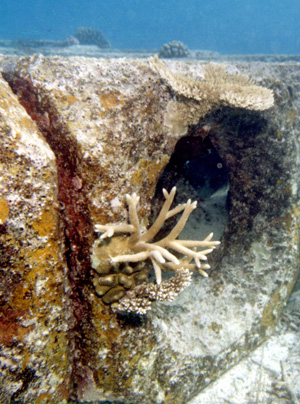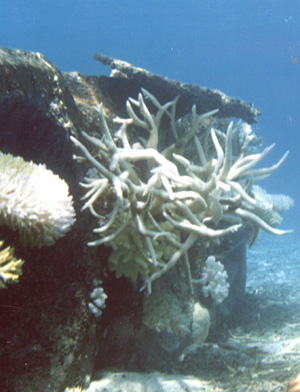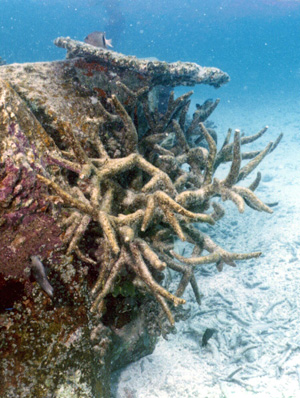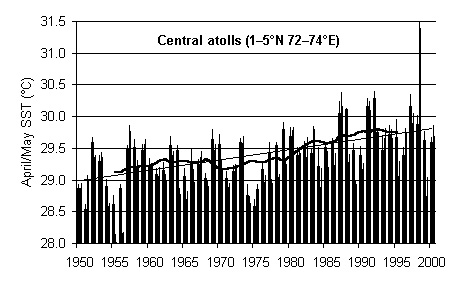|
|
Staff involved:Alasdair Edwards, Susan Clark, Hussein Zahir and Abdulla Naseer (Ministry of Fisheries, Agriculture & Marine Resources, Maldives), Arjan Rajasuriya (National Aquatic Resources Research & Development Agency, Sri Lanka), Jason Rubens (GCRMN South Asia)Funding:Department for International Development
Acropora cytherea (foreground, top), A. valenciennesi, Pocillopora verrucosa and A. divaricata (left hand side) colonies on a SHED block in September 1994.
The same and adjacent bleached colonies on 12 May 1998 at the height of the bleaching event.
The same corals on 31 July 1998, now dead and covered in algae. |
SST anomalies and mass coral bleaching and mortality in the Maldives in 1998ProjectBleaching and subsequent mortality of branching and massive corals on artificial and natural reefs in the central atolls of the Maldives in 1998 were examined with respect to sea surface temperature (SST) anomalies. SST normally peaks in April/May in Maldives. The UK Meteorological Office's Global sea-Ice and Sea Surface Temperature data set version 2.3b showed that in 1998 monthly mean SST was 1.2-4 standard deviations above the 1950-1999 average during the warmest months (March-June), with the greatest anomaly in May of +2.1°C. Bleaching was first reported in mid-April and was severe from late April to mid-May with some recovery evident by late-May. At least 98% of branching corals (Acroporidae, Pocilloporidae) on artificial structures deployed on a reef flat in 1990 died whereas the majority of massive corals (Poritidae, Faviidae, Agariciidae) survived the bleaching.
The pre-bleaching coral community on the artificial reefs in 1994 was 95% branching corals and 5% massives (n=1589); the post-bleaching community was 3% branching corals and 97% massives (n=248). Significant reductions in live coral cover were seen at all natural reefs surveyed in the central atolls, with average live coral cover decreasing from about 42% to 2%, a twenty-fold reduction from pre-bleaching levels. A survey of recruitment of juvenile corals to the artificial structures 10 months after the bleaching event showed that 67% of recruits (> 0.5 cm diameter) were acroporids and pocilloporids and 33% were from massive families (n=202) compared to 94% and 6% respectively in 1990-1994 (n=3136). Similar post-bleaching dominance of recruitment by branching corals was seen on nearby natural reef (78% acroporids and pocilloporids; 22% massives). A linear regression of April mean monthly SST against year was highly significant (P < 0.001) and suggests a rise of 0.16°C per decade. SignificanceIf this trend in sea surface temperature rise continues, by 2030 mean April SST in the central atolls will normally exceed the anomaly level at which corals there appear susceptible to mass bleaching. Future directionsWe continue to monitor recruitment of corals and the recovery of reefs following the 1998 mass bleaching and mortality event. References
|



 The long-term context of the 1998 warming event. In Maldives sea surface temperatures
normally peak in April but occasionally in May. Mean monthly SSTs for the central Maldives,
for April and May from 1950-2000, are shown together with the least-squares best-fit linear
regression line (P < 0.001) and 11-year running average for April SST to show decadal-scale
trends.
Lines extending upwards from columns indicate the highest SST recorded among the eight 1°
squares comprising the study area. Major coral bleaching was recorded in 1987 and 1998.
Mean monthly SST in May 1998 was a full degree warmer than anytime in the previous half-century.
The long-term context of the 1998 warming event. In Maldives sea surface temperatures
normally peak in April but occasionally in May. Mean monthly SSTs for the central Maldives,
for April and May from 1950-2000, are shown together with the least-squares best-fit linear
regression line (P < 0.001) and 11-year running average for April SST to show decadal-scale
trends.
Lines extending upwards from columns indicate the highest SST recorded among the eight 1°
squares comprising the study area. Major coral bleaching was recorded in 1987 and 1998.
Mean monthly SST in May 1998 was a full degree warmer than anytime in the previous half-century.